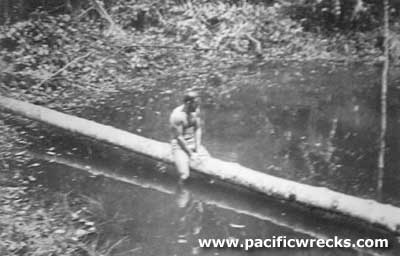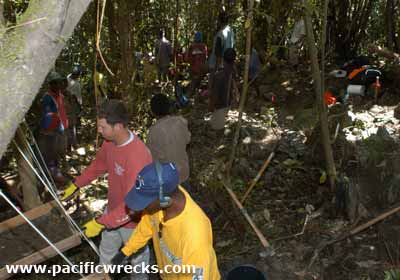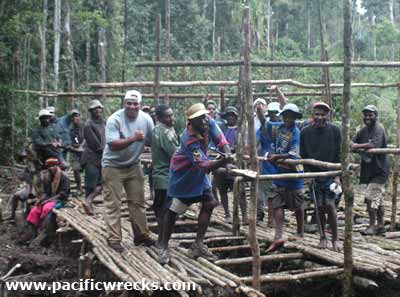|
|
| Missing In Action (MIA) | Prisoners Of War (POW) | Unexploded Ordnance (UXO) |
| Chronology | Locations | Aircraft | Ships | Submit Info | How You Can Help | Donate |
|
| USAAF 5th AF 38th BG 405th BS  Al Simmons c1942  The Searchers 1961  JPAC 2004    JPAC 2005  Phil Bradley 2006  Gary Traynor 2008 |
Pilot 1st
Lt. Wilson L. Pinkstaff, O-424664 (MIA / KIA, BR) IL Co-Pilot 1st Lt. Charles L. Maggart, O-430935 (MIA / KIA, BR) IN Navigator 2nd Lt William N. Stocking, O-434888 (MIA / KIA, BR) TX Bombardier 2nd Lt. Frank Thompson, O-659607 (MIA / KIA, BR) CA Radio Sgt Aubrey "Aub" L. Atkins, Jr, 14053731 (MIA / KIA, BR) Athens, LA Engineer Cpl Richard P. Grutza, 16947009 (MIA / KIA, BR) Milwaukee, WI Gunner Pfc Antonio P. Calderon, 38013441 (MIA / KIA, BR) NM MIA December 5, 1942 MACR 15902 Aircraft History Built by North American Aviation (NAA) in Inglewood. Constructors Number 82-5542. Delivered to the U.S. Army Air Force (USAAF) as B-25C Mitchell serial number 41-12907. Ferried overseas by 2nd Lt. Garrett E. Middlebrook from the United States via Hickam Field then across the Pacific to Australia arriving in August 1942. Wartime History Assigned to the 5th Air Force (5th AF), 38th Bombardment Group (38th BG), 405th Bombardment Squadron (405th BS). Nicknamed "The Happy Legend". Mission History On December 5, 1942 took off from 7 Mile Drome near Port Moresby piloted by 1st Lt. Wilson L. Pinkstaff as one of six B-25s from the 405th Bombardment Squadron (405th BS) plus three B-25s from the 71st Bombardment Squadron (71st BS) on a bombing mission against Japanese troop concentrations at Buna. This B-25 took off late, and it is unclear if it joined the formation or lagged behind. One pilot thought he saw the B-25 alongside, until it flew into a cloud bank over the Owen Stanley Range and was never seen again. When this B-25 failed to return it was officially listed as Missing In Action (MIA). In fact, this bomber crashed in the vicinity of Myola near the Kokoda Gap. Wreckage On impact, this B-25 likely exploded in the trees and created a large impact crater that filled with water submerging the wreckage. After crashing, several aerial bombs remained inside unexploded. Recovery of Remains On February 5, 1943 the crash site was discovered by Australian Army 1st Australian Corps personnel including Signaler Humphrey F. Peterson, QX700193 and LCpl J. MacDonald located the crash site. The Australians found the remains of Pinkstaff and found Atkin's dog tags. Since Japanese forces were believed to be in the immediate area, the Australians were unable to search for the remains of the crew. Afterwards, the crash site was visited by at least eight U.S. recovery teams between 1961–2002, including: 1) During July 1961, RAAF Searcher mission, with American military team members visited the site, but had to abandon any further search due to water in the crater. 2) On June 9, 1986 a team from US Army CILHI comprising of 1st Sgt David Kelly and Staff Sgt George Horn and PNG Museum director Bruce Hoy visited the crash site via Bell 206 P2-FHE and remained at the site for 30 minutes and assessed it for recovery at a later time. 3) On July 5-7, 1986 another US Army CILHI team visited the crash site (mission number 11/CIL/86). The team was augmented by two further members on 6 July and the next day the mission commander arrived from Mount Obree, where the rest of the team were conducting the first clearing operation of B-17E 41-2505. During this mission, no remains were recovered, one of the two pumps failed, and the team leader considered any further attempts will depend on an engineer advising on how the seepage can be stopped. Bruce Hoy adds: "It's mission number was 11/CIL/86. That is probably where the 11 comes from with the number of times JPAC considers they have been to the crash-site and the 11 has nothing to do with the number of times the site has been excavated. The writer of the report got the aircraft's serial number wrong. I am pretty certain a team went in later between 1986 and 1991 and conducted a partial recovery as I seem to recall reading a CILHI report about it." 4) During 1995, the site was partially excavated by US Army CILHI and resulted in the recovery of Atkins' dog tag. Major Mark A. Magalski, U.S. Army CILHI adds: "This crash site was partially excavated in 1995." 5) During 2001 visit, the impact crater was drained and excavated and 'wet remains' (preserved tissue) were found on site. Also found were black & white photos including a family photo and a brief case. The excavation was visited by US Ambassador to PNG Susan Jacobs and embassy staff. Brian Bennett was on the May 2001 recovery: "There is a large impact crater where this aircraft dived in with a full bomb load. It went in on the way out not on the way back to Port Moresby. Probably tried to fly under cloud base and got closed out. This crash site was the subject of repeated recovery missions both under CILHI and later JPAC. A very difficult recovery this one and at one stage I was on site for about two weeks. The crew were fragmented and quite a lot of 'wet' remains were recovered. I recall a brief case being retrieved from the crash crater but what the contents were I never knew the contents of the brief case - navigators i think it was. I recall also some very good black and white photos coming out as well. I would think that this case may have ended up as a group burial." 6) During 2002 US Army CILHI attempted to complete the excavation. Field reports from the team indicated they were forced to suspend work at the site due to safety concerns. The team indicated the aircraft wreckage itself is in an unstable, precarious position and they also discovered ordinance. Major Mark A. Magalski, U.S. Army CILHI adds: "During the 2002 mission, the CILHI team's objective was to attempt to complete the excavation. Preliminary field reports from the team indicate they were forced to suspend work at the site due to safety concerns. The team indicated the aircraft wreckage itself is in an unstable, precarious position and they also ran into live ordnance." 7) During March 2002 US Army CILHI went back to the site and attempted to complete the recovery. During tile course of pumping out the crater, a 500 lbs bomb, which was lodged in the side of the crater, began to shift. Attempts to reinforce the bomb were unsuccessful, and it began a slow descent to the center of the crater in the middle of the excavation area. After examination by the US EOD specialists and the PNG Defense Force EOD team, it was determined that the bomb was too unstable to move and the only alternative would be to blow it in place. Unfortunately, this would destroy whatever remained of the site. Due to safety concerns, the site was administratively closed on 15 March 2002 and the team relocated to another recovery site near Lae. Major Mark A. Magalski, U.S. Army CILHI adds: "In March 2002, CILHI went back to the site and attempted to complete the recovery. During tile course of pumping out the crater, a 500 lb bomb, which was lodged in the side of the crater, began to shift. Attempts to reinforce the bomb were unsuccessful, and it began a slow descent to the center of the crater in the middle of the excavation area. After examination by the US EOD specialists and the PNG Defense Force EOD team, it was determined that the bomb was too unstable to move and the only alternative would be to blow it in place. Unfortunately, this would destroy whatever remained of the site. Due to safety concerns, the site was administratively closed on 15 March 2002 and the team relocated to another recovery site near Lae. It was a difficult site to excavate, but it gives our teams a sense of pride when we can provide some sense of closure to family members. We will remain vigilant in our efforts here until all missing service members are brought home." 8) During January until early March 2005 another JPAC team visited the site as part of the JPAC mission in Papua New Guinea & Fiji. They located more possible remains and personal effects including a personal identification bracelet. Relative Phil Maggart identified a total of eleven American visits to the crash site. Likely, US Army CILHI and/or JPAC visited this crash site on three other occasions, details or duration of visit are unknown. After the extensive recovery operations at this crash site, JPAC positively identified their remains. During late September 2008 the Department of Defense (DoD) notified family members about the positive identifications. Since the 2005 recovery mission, some of the wreckage from this crash site, including a main undercarriage leg with tire is displayed near Myola village, and often photographed by trekkers on the Kokoda Trail. Memorials The entire crew was declared dead the day of the mission. All are memorialized at Manila American Cemetery on the tablets of the missing. Pinkstaff has a memorial marker at Lawrenceville City Cemetery in Lawrenceville, IL at section A. After the recovery of remains, the remains of the crew that could not be identified were buried on November 17, 2009 in a group burial at Arlington National Cemetery at section 60, grave 9194. After the recovery and identification of additional remains, individual graves were added for each of the crew. Three of the crew that were individually identified and their families wished to have them permanently buried in hometown or state veterans cemeteries. Grutza was buried on December 17, 2008 at Saint Adalberts Cemetery in Milwaukee, WI at section 2 block 29 row 12 grave 13. Calderon was buried on May 8, 2009 at Fort Bayard National Cemetery in Fort Bayard, NM at section F, row H, grave 53. Atkins was buried on May 16, 2009 at Salem Cemetery in Athens, Louisiana Relatives Phil Maggart (brother of Charles L. Maggart): "I just received official word [September 24, 2008] from the Defense Depart, Department of the Army, Defense Prisoner of War/Missing Personnel Office--Mr. Lincoln Berry, that Lt. Charles L. Maggart, has been positively identified and that representatives from the Casual Office will be visiting soon to make final arrangements for internment. Sixty-six years I have been searching for closer, now it has finally happened. I just researched my records and found out that there have been 11 [American] visits to this site." Frankie Romero (great nephew of Calderon): "My family recently received notice that the remains of my great uncle Antonio "Tony" Calderon were identified in the wreckage of "The Happy Legend". Tony was my grandmothers brother and I never knew him but heard stories of him as a boy that he had been an aerial gunner in WWII but was killed in action. Never knowing exactly what happened to Tony was always a source of remorse for our family and I wish my grandmother would have lived to see this day, she missed Tony dearly." John Stocking (1st cousin William N. Stocking): "It was a shock to me and my brothers and sisters that William N. Stocking's remains were found. I spoke to his brother and his grandfather while I was stationed at Fort Hood, TX (1954-56). They told me the plane blew up over the ocean - that's all they knew at the time." Ken Moody (nephew of Aubrey L. Atkins) "I remember Atkins as a child, I was seven when he went missing. He always wanted to live in this one house in our town. With his insurance money, the family bought that house." References USAF Serial Number Search Results - B-25C Mitchell 41-12907 "12907 in accident Dec 6, 1943" [sic crashed December 5, 1942] 38th BG History Diary list pilot as Pinkstaff and co-pilot as Maggart Missing Air Crew Report 15902 (MACR 15902) lists pilot as Maggart and co-pilot as Pinkstaff American Battle Monuments Commission (ABMC) - Wilson L. Pinkstaff "His remains were recovered." American Battle Monuments Commission (ABMC) - Charles L. Maggart "His remains were recovered." American Battle Monuments Commission (ABMC) - William N. Stocking "His remains were recovered." American Battle Monuments Commission (ABMC) - Frank Thompson "His remains were recovered." American Battle Monuments Commission (ABMC) - Aub L. Atkins Jr. "His remains were recovered." American Battle Monuments Commission (ABMC) - Richard P. Grutza "His remains have been recovered." American Battle Monuments Commission (ABMC) - Antonio P. Calderon "His remains were recovered." FindAGrave - Wilson L Pinkstaff (group burial photo) FindAGrave - Wilson Levi Pinkstaff (memorial marker photo) FindAGrave - Charles L Maggart (group burial photo) FindAGrave - Lieut William N Stocking (group burial photo, grave photo) FindAGrave - Frank Thompson (group burial photo) FindAGrave - Sgt Aubie Lee "Aub" Atkins, Jr (photo, grave photo) FindAGrave - Richard P Grutza (group burial photo) FindAGrave - Corp Richard P Grutza (grave photo) FindAGrave - Antonio P Calderon (group burial photo) FindAGrave - Antonio P. Calderon (grave photo) PNG Museum Aircraft Status Card - B-25C Mitchell 41-12907 states the aircraft's nickname was "SCAT" The Searchers (1999) page 146 CILHI / JPAC mission updates via Mark A. Magalski, 2002 and C. Willamson. 2004 & 2005 photos via JPAC / Major Nielson-Green JPAC News Release "JPAC Team Deploys to Papua New Guinea, Fiji" January 21, 2005 KTBS "After six decades, Aub Atkins comes home" May 13, 2009 Thanks to Bruce Hoy, Larry Hickey, Phil Maggart and Mark A. Magalski for additional information Contribute Information Are you a relative or associated with any person mentioned? Do you have photos or additional information to add? Last Updated December 10, 2025 |
B-25 MIA 7 Missing Resolved 8° 59' 147° 5' View on Google Earth Photo Archive |
| Discussion Forum | Daily Updates | Reviews | Museums | Interviews & Oral Histories |
|